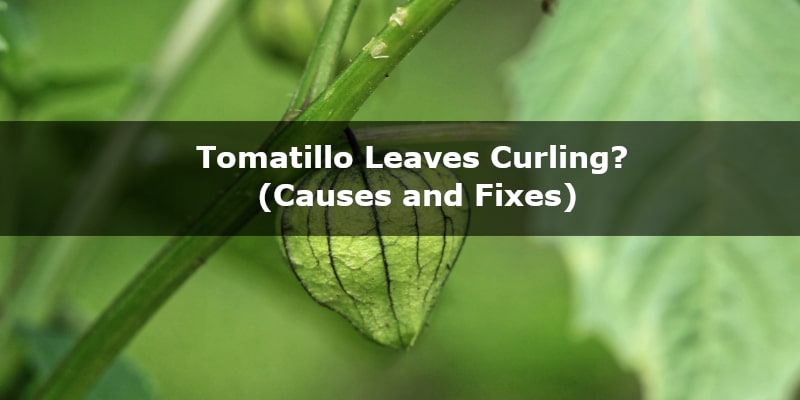So, your tomatillo leaves are curling?
Don’t worry. In this article, I will list all the potential causes, and tell you if you can save your plant.
Why are Your Tomatillo Leaves Curling?
There are 7 potential causes of tomatillo leaves curling. However, the most possible ones are Tobacco Mosaic Virus, nutrient imbalance, and extreme weather conditions.
Tomacco Mosaic Virus that is transmitted by whiteflies s a common cause of curling tomatillo leaves. However, too much nitrogen, or too little phosphorus might also be the cause.
There are more causes. Keep on reading to identify the cause, and learn how you can save your tomatillo plant.
Tobacco Mosaic Virus (TMV)
Tobacco Mosaic Virus is a plant virus. Tomatillo plants can get infected if you have TMV in other parts of your garden.
The two main symptoms of TMV include curled leaves and yellow discoloration on the leaves between the leaf veins. TMV is spread by whiteflies who carry the disease to tomatoes and tomato-related plants, like tomatillo.
If you have identified that your tomatillos have TMV, there is nothing you can do to treat or stop it. TMV-infected plants must be thrown out or destroyed, and never composted. The virus can easily spread to other tomatillos or tomato plants, so always wash your hands after handling infected plants.
If you’ve confirmed that your tomatillos have been infected with TMV, it’s advised to not plant any nightshade like tomato, pepper, potato, or eggplant in the same bed for at least two years.
Nutrient Imbalance
Tomatillos that have been overfertilized with nitrogen may show upward curled leaves that are thicker and greener than usual, and also lots of foliage instead of setting fruit.
Problems with extra nitrogen typically resolve themselves over time. As leaf curl has little impact on the plant yield or overall health, you should simply wait for them to return to normal.
Insufficient phosphorus might also lead to leaf curl.
When planting tomatillos, use a balanced fertilizer containing a good mixture of nitrogen, phosphorus, and potassium (like this one on Amazon).
When the plant starts producing fruit, a phosphorus and potassium fertilizer is recommended, as those are the nutrients needed for flowering and fruiting.
The best way to determine the nutrient content in the soil is with a pH soil tester that you can buy here on Amazon.
Extreme Weather Conditions
Leaf curl is primarily driven by hot weather, lack of moisture, and heat stress. In overly hot and dry conditions, the leaf margins roll upwards. Usually, more curling occurs on the lower leaves.
Leaf curl indicates that the plant actively protects itself. When hot, dry conditions persist, tomatillo plants are not able to take up as much water as they lose through evaporation. This internal water deficit causes leaflets to curl up. A curled leaf absorbs less of the sun’s energy and loses less water.
To save your tomatillo plant, provide the plant with 1 inch (16 ml) of water a week. If plants don’t receive that amount from rainfall, supplement by delivering water right to the root zone with a hose or drip line. You can also add a 2-inch (5 cm) layer of mulch around tomatillo plants to limit soil moisture evaporation.
Leaf curl caused by extreme weather conditions shouldn’t significantly affect plant growth or yield.
Herbicide Exposure
Tomatillo plants are very sensitive to herbicides. They cause leaf curl if they come into contact with your plants. If you don’t use herbicides, it might be your neighbors’ fault.
When exposed to herbicides, the leaves tend to curl downwards and twist around the stem. New growth typically exhibits these signs first.
Herbicides can sometimes kill your tomatillo plants. However, if the damage is mild, new growth may grow unaffected, but the yield will be reduced.
Transplant Shock
If you’ve recently transplanted tomatillo plants, and you notice leaf curl, it’s because of transplant shock.
Tomatillo roots are very sensitive, and even the slightest nick can result in root disturbance. As the plant begins to settle into its new spot, it may show signs of this root damage through leaf curl, wilting, or yellowing leaves.
If you were careful when transplanting, the transplant shock should pass within a week or two
Excessive Pruning
Excessive pruning of your tomatillo plants results in stress, which causes the leaves to curl. It also exposes more of the plant to the sun, making it susceptible to the heat problems discussed before.
The good news is that stress should resolve itself in a couple of weeks, with the leaves returning to normal.
Instead of excessive pruning, you should do slight pruning by pinching off the suckers between the main and lateral stems. The removal of a very small amount of leaves may also improve growth and air circulation.
Planting Too Early
Tomatillos, that have been planted too early when the weather was too cool, can suffer from leaf curl. It usually starts with the lower leaves curling upwards, then rolling inwards lengthwise. The leaves also become thick and leathery, but usually remain green.
Make sure to plant tomatillos only when daytime temperatures consistently reach between 70-79 °F (21-26 °C) and nighttime temperatures are no lower than 61 °F (16 °C).Â
Sources
bountifulgardener.com, tomatobible.com, thespruce.com, bhg.com

